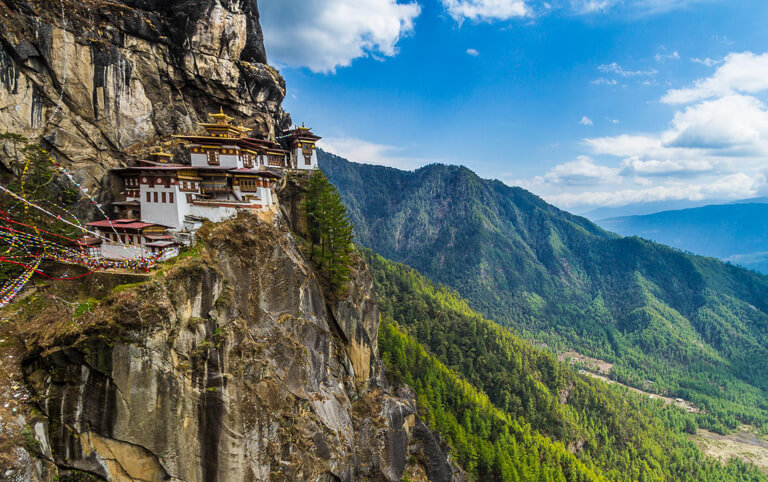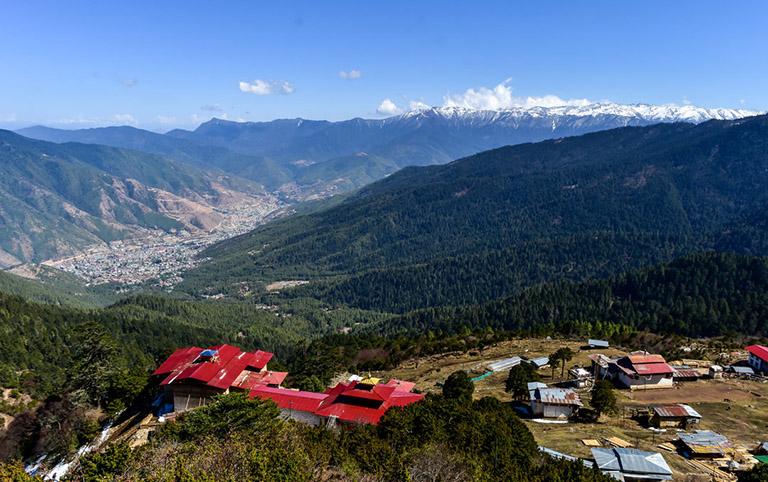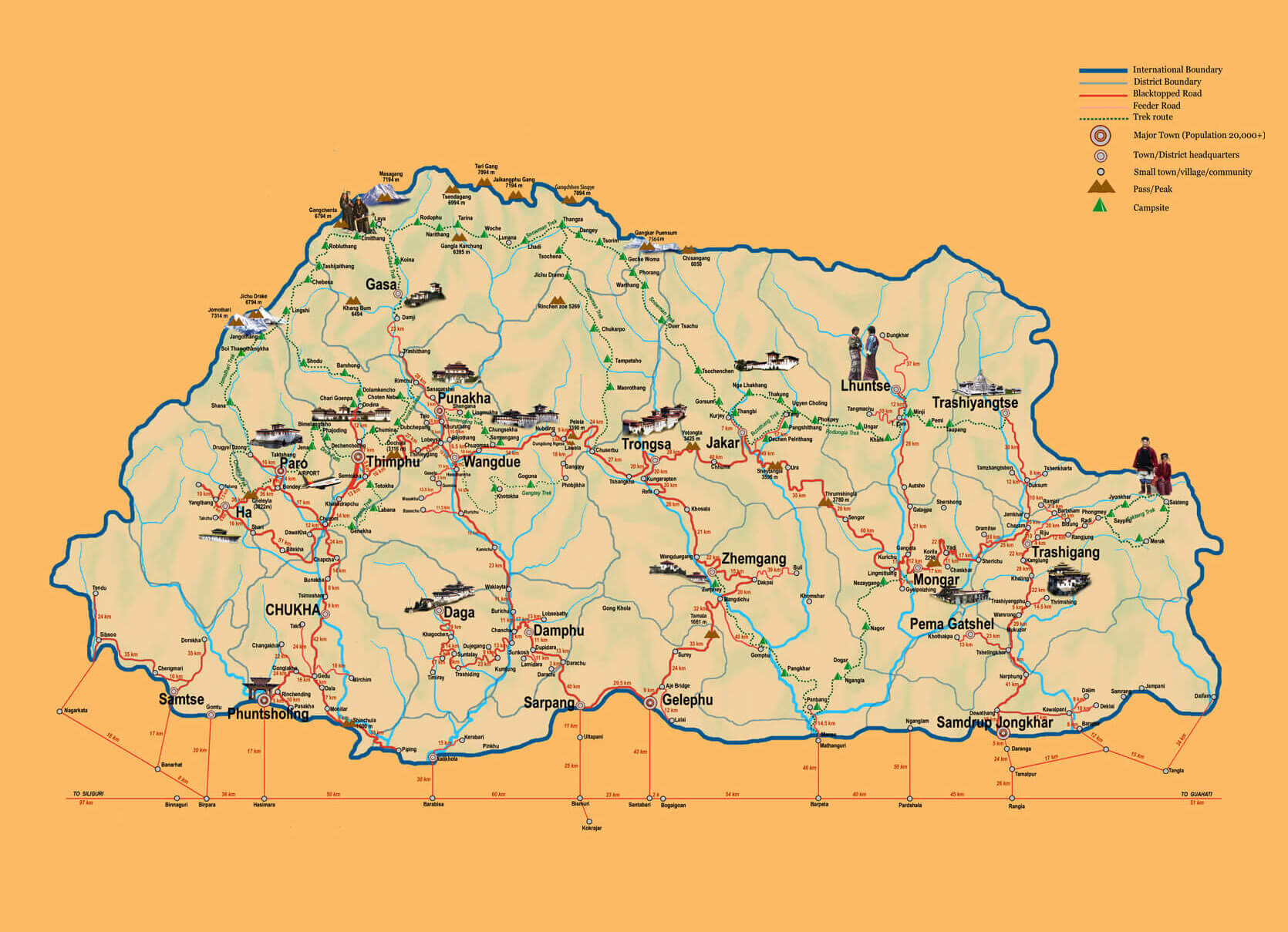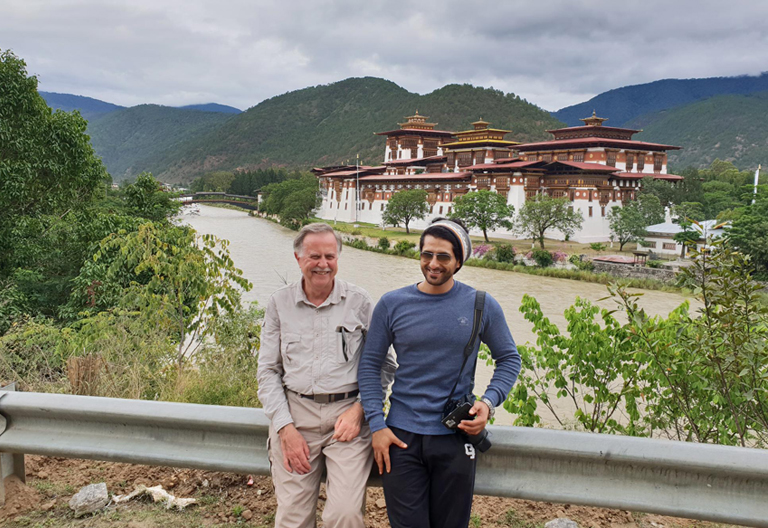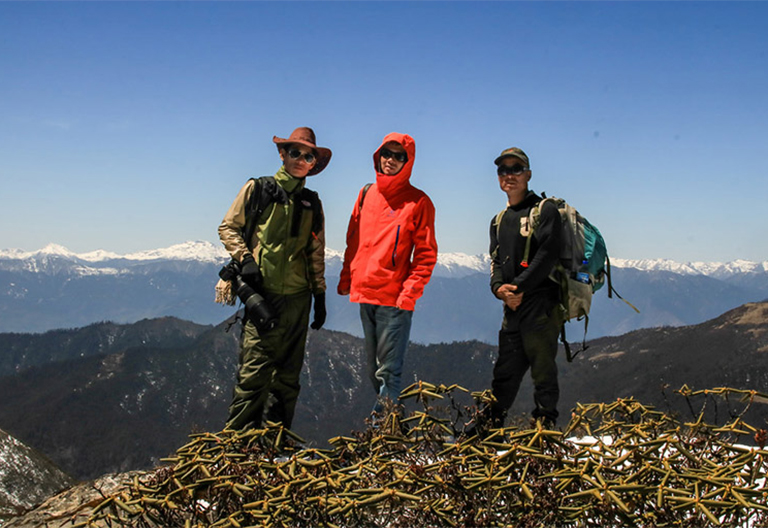
Ultimate Bhutan Trekking Guide & Best Bhutan Trekking Tours
With both beauty and variety, Bhutan satisfy all your fancy imagination about trekking. Unspoilt mountain trails, perfect weather, warmhearted atmosphere, majestic Himalayan mountains, imposing glaciers, pristine plateau lakes await you to explore in this happiest place on earth. Whether you are looking for a glimpse of the Land of Thunder Dragon, or keen on a grueling long trek, Bhutan has it all for you. Short treks, such as the Druk Path Trek, Owl Trek, Chomolhari Trek, etc., offer an insight to the Himalaya within a short duration, and long (serious) treks fulfill your ambition to conquer some of the most challenging high-altitude treks in the world. All the treks are very enjoyable as you will have ones of the best trekking teams in the world to support you.
Bhutan Trekking Style - Most Enjoyable Trekking in the world
According to Bhutan's tourism policy, tourists have to trek Bhutan with a guided tour provided by Bhutan travel agencies, which doesn’t mean the lessening of flexibility of your trek. You can still choose the places to go, pace of trek, tour guide, food, etc. Many people even agree that Bhutan trekking is the most enjoyable trekking in the world.
- ● All-inclusive package to ensure a worry-free trek for you;
- ● High-quality trekking gears and camping gears are all provided by the tour operator; you only need to bring your own stuffs;
- ● There is a professional licensed trekking team, usually consisting of tour leader, trekking assistant, porter and chef, to serve only for you (or your group);
- ● Fresh vegetable, meat and other food and drinks are provided every day;
- ● Shower tent is available if you need;
- ● The services of Bhutan visa and required trekking permits are included in your package.
It is the time to go - book a Bhutan trek or let’s together customize one now to enjoy superb fun of trekking. Below are most popular and classic trekking routes in Bhutan:
-
Tiger's Nest Trek – 1 Day (EASY)
– Best Acclimatization Trek Before High Altitude Treks

Cliffside Tiger's Nest Monastery

Trekking to Tiger's Nest Monastery
The Tiger’s Nest (or Takstang Monastery) is the most extraordinary spot in Bhutan. It is a beautiful Buddhist monastery precariously perched on a cliff 900 meters off of the ground. To get to the monastery, you need to take an uphill hiking about 3.5 kilometers. Due to its high location (at 3100 meters), there is no vehicle that can drive you up there.
Most trekkers like to take an acclimatization trek to Tiger’s Nest Monastery before starting other longer treks, such as Druk Path, Chomolhari Trek, etc., because the attitude gaining is about 518 m and the max altitude is about 3100 m, which is helpful to adapt the altitude and air pressure. Starting at the feet of the mountain, the first half of the Tiger’s Nest Trek is uphill the entire way but not very steep along a wide and dirt trail. It is not a hard climb but costing time about 1.5~5 hours. You will pass under a lot of prayer flats, and have many chances to look far upon the Tiger’s Nest Monastery. The first half trek finishes at the Takstang Cafeteria which is about equal-high with Tiger’s Nest Monastery. The second half trek leads you from the Cafeteria to the scenic area of Tiger’s Nest Monastery. It is easier and not as steep as the first half trek. As you walking approaching to the monastery, you will find many opportunities to overlook the magnificence of Tiger’ Nest Monastery and take photos. Finishing the short walking down to a bridge, and make a slight climb, you will finally reach the monastery. Visit the monastery freely about 1 hour before hike the same way you came. The entire trek including monastery visit usually costs about 6~7 hours to finish.
Best time: March to May / September to November
Elevation: from 2580 meters to 3100 meters
Trekking duration: a day fro ParoRecommended Bhutan Tour including Tiger's Nest Trekking:
☞ 5 Days Bhutan Classic Tour (Paro & Thimphu & Punakha)
☞ 9 Days Bhutan In-depth Natural and Cultural Tour -
Druk Path Trek – 4 Days (EASY)
– Recommended for Beginners

Druk Path Trekking in March

Overlooking Thimphu City
The Druk Path Trek is ideal for beginners and those who prefer a leisure and scenic trekking. Following an ancient trading route, you will trek along the beautiful mountain trails crossing the small mountain range between Paro and Thimphu, rewarded with stunning mountainous landscape willed with ancient Buddhist temples, rural villages, blue pine forests, dwarf rhododendrons and crystal pure lakes. You will also enjoy a far-reaching view as far as to Gangar Puensum (7570 m - the highest unclimbed peak in the world). There are also a lot of opportunities to see many beautiful lakes during the trek. The highest-altitude location in this trek is Phume La Pass (4210 meters). As a fairly easy trek, the Druk Path Trek can easily be added to most of the other Tibet tours, including itineraries to Tiger’s Nest, Thimphu, Punakha, Bumthang, etc. Please feel free to contact us to customize a tour >
Best time: March to May / September to November
Elevation: from 2870 meters to 3610 meters
Trekking distance: 4 daysRecommended Bhutan Tour including Druk Path Trekking:
-
Chomolhari Trek - 7 Days (EASY)
- Off-the-beaten path, high altitude experience

Camping in front of Mount Chomolhari

Climbing over a pass during Chomolhari Trek
The Chomolhari Trek is fantastic for trekkers looking for a high altitude experience that isn't too long. Tougher than the Druk Path trek, the Chomolhari Trek is a 6-day challenging trek which requires a good level of fitness. Trekkers need to climb over several high passes over 4800 m, and spend more time at the higher altitudes. The altitudes of the campsites are mostly below 4000 m except Chomolhari Base Camp (4040 m) and Shodu (4080 m). The Chomolhari Trek is full of both mountain scenery and cultural highlights. The trail starts at the ancient ruin of Drugyan Dzong, goes up the beautiful Paro Valley to Jangothang Base Camp from where you can enjoy the spectacular views of Mt. Jumolhari (7326 m), the second-highest unclimbed peak in the world, pass by rural village of Shana and others. The Chomolhari trek is one of the most modern treks in Bhutan either with electricity supply following the trail up the Paro Valley.
Best time: April to May / September to November
Elevation: from 2500 meters to 5000 meters
Trekking duration: 9 days☞ Contact Us to learn more about Chomolhari trek
-
Dagala Thousand Lakes Trek – 6 Days (MODERATE)
– Recommended for Nature Lovers

Beautiful lake during Dagala Thousand Lakes Trek

Mount Kanchenjunga - the 3rd highest peak in the world
Although the starting point and the end point of the Dagala Thousand Lakes Trail are similar to the Thunder Dragon Trail, the routes are completely non-coincident, so the scenery along the way is also completely different. Dagala Thousand Lake Trek is harder little bit than the Druk Path Trek because there are several steeper uphills along the trek, and the highest altitude (4700 m) is also higher.
As the name implies, Dagala Thousand Lakes Trek passes by a lot of lakes (but less than 1000… about 40 in fact). In addition to lake, you will walk through vast forests of rhododendron that bloom brilliantly in March ~ April, camp in yak pastures, isolated meadows, and beside tranquil lakes. The incredible view of Himalayan ranges is another highlight of this trek. In clear days, you can catch the wonderful views of Mt. Kanchenjunga, the 3rd highest mountain in the world from Pagalabtsa Pass (4170 m). Other mountains you can see along the trek include Mount Everest, Chomolhari, Jichu Drake, Tshering Gang, Khangbum, Masang Gang, etc.
Best time: March to May / September to October
Elevation: from 2300 meters to 4700 meters
Trekking duration: 6 days☞ Contact Us to learn more about Dagala Thousand Lakes Trek
-
Snowman Trek - 25 Days (HARD)
– One of the hardest trek in the world

Jejekangphu Kang in the Clouds

Chebisa Village along the Snowman Trek
You can not really see the snowman on the Snowman Trek. It is called as Snowman trek because this route is very difficult to complete, and it will definitely encounter strong snowfalls which make the trekkers look like snowmen. The Snowman Trek is widely believed as one of the most difficult treks in the world, even harder than Everest summiting. But you will be compensated by the pristine landscape of Himalaya and magnificent beauty in the remote and unspoiled parts of Bhutan.
The Snowman Trek starts in Paro on the west side of Bhutan and ends in Thongsa, the central hinterland of Bhutan, traversing the mountains border region between Bhutan and Tibet. Costing approximately 25 days to complete, the Snowman Trek has a total distance is 350 kilometers, and a total of 11 passes over 4800 meters above sea level, 4 of which are above 5000 meters. If the weather is good, you will see 10 snow-capped mountains in the Himalayas above 6,800 meters, including the highest peak in Bhutan - Gungga Benson Peak, and the second highest peak - Drumura Peak.
According to official statistics from the Bhutan Tourism Bureau, the chance of successful finishing the Snowman Trek is currently around 50%. The biggest challenge that hinders hikers from completing this route is the weather and altitude sickness. On the snowman hiking route, more than half of the time is spent at ascending and asending higher, and there are 4 passes over 5000 meters to be conquered. Another challenge is there are few villages to get supply on this trek, and the chances for helicopter rescue are slim. Purchasing an emergency evacuation is very necessary.
It is common to encounter snowstorms on the Snowman route, because the altitude is high and the weather is unpredictable. If you encounter heavy snow, the general horses carrying hiking materials cannot go forward. You must use the yaks.
Best time: September to October
Elevation: from 2300 meters to 5300 meters
Trekking duration: 25 days☞ Contact Us to learn more about Snowman Trek
-
Other Bhutan Trekking Routes
– Natural Trek, Flower Trek, Winter Trek ...
Bhutan Treks Themes Start-End Duration Elevation Range Difficulty Landscape Best Time Gangtey Natural Trek Beautiful Valley Gangtey 0.5 Day~3 Days 2300m~3100m 2 Stars 4 Stars Mar~May/Spt~Nov Sagala Haa Trek Flower Haa-Paro 1 Day 3000m~3900m 2 Stars 4 Stars Mar~May/Spt~Nov Bumthang Culture Trek Culture Bumthang 3 Days 1200m~3300m 2 Stars 3 Stars Mar~May/Oct~Dec Bumthang Owl Trek Night Trek Bumthang 3 Days 2200m~4000m 3 Stars 4 Stars Mar~May/Oct~Dec Punakha Winter Trek Winter Thimphu-Punakha 3 Days 2300m~3400m 2 Stars 3 Stars Mar~May/Spt~Nov Chomolhari Loop Trek Mt. Chomolhari Paro 7 Days 2500m~5000m 3 Stars 5 Stars Apr~May/Spt~Nov Chomolhari Laya-Gasa Trek Adventure Paro-Gasa 12 Days 2500m~5000m 4 Stars 5 Stars Apr~May/Spt~Nov Duer Hot Spring Trek Hot Spring Trongsa 9 Days 3000m~4700m 4 Stars 5 Stars Mar~May/Spt~Nov If above Bhutan treks are not your types, you can always find another suitable trek. Please don't hesitage to contact us for more suggestions.
A Bhutan Visa Is Required for Bhutan Treks
Unless you are passport holders of the Maldives, India or Bangladesh, you are required to have a visa to visit Bhutan, and the only way to obtain one is through a licensed tour operator in Bhutan. Fortunately, the process to obtain Bhutan Visa is quite simple – you book a tour with a Bhutan tour operator like us, and send a photocopy of your valid passport. Your tour operator (like us) will apply the visa with Bhutan Tourism Council. A visa clearance letter will be mailed to you. You showcase the visa clearance letter when checking in the immigration offices of Bhutan, either at Paro Airport or other border ports. The Bhutan Visa will then be stamped on the visa page of your passport, and you are all good to enjoy your Bhutan vacation. The visa costs $40 per person. Regular process from application submission to receiving visa clearance letters costs about 7~10 working days. Learn more about Bhutan Visa >
Is Bhutan Trekking Expensive?
Trekking in Bhutan is usually more expensive than many other treks in the world, because, according to tourism policy of Royal Bhutan Government, international tourists (excluding Indian, Maldivian and Bangladesh) have to pay a minimum charge (official name as Daily Fee) per day per person, which covers most expenses in your trekking, including treak gears, accommodation, tour guide, food, chef, porters, Sustainable Development Fee, etc. The Daily Fee differs by tourism seasons:
● USD 250 per person per day for the months of March, April, May, September, October and November.
● USD 200 per person per day for the months of January, February, June, July, August and December.
Bhutan Trekking Seasons and Best Time
Bhutan trekking is only recommended during March to May and September to November when is the tourist peak season of Bhutan tourism, and respectively spring and autumn. It’s important to avoid trekking during monsoon season (June to August) when there are plenty of rainfalls, which is unsafe for trekking, especially along the southwestern border area. Winter (December to February) should be avoided either. The temperatures drop down rapidly as you trek close to the HImalya mountains, and you are more prone to heavy snowfall, which is dangerous for trekking.
Weather in Spring
The temperatures begin to rise but still remain slight chill in March (average temperature: 13°C), then get completely warm and comfortable in April (average temperature: 16°C) in most parts of Nepal. In May (average temperature: 19°C), it usually doesn’t get hotter rapidly, and sporadic drizzle occur after middle May. Sunny days are plentiful and continuous in Spring season. All these weather advantages make spring one of the best time to enjoy a trek in Bhutan.
Weather in Autumn
The summer heat starts to cool and frequent rainfall begins to fade away when the September (average temperature: 20°C) comes, which means another trekking season comes. October (average temperature: 18°C) is warm and sunny all the time. The temperatures start to decline gradually in November (average temperature: 14°C) but still pleasant for a trek.
Is It Crowded During Peak Seasons?
Bhutan focuses on “low volume, high quality” tourism. The country has a very small population of around 750,000, and the government limits the number of foreign visitors to a minimum. So don’t have to worry about experiencing many crowds.
How to Get to Bhutan – by International Flights or Overland
Bhutan can be reached by international flights from India, Bangladesh, Thailand or Nepal. In some high seasons, Indonesia and Malaysia also operate flights to Bhutan. The main airport is in Paro, which is the only international airport in entire Bhutan, about an hour’s driving away from Thimphu, the capital city. Sometimes the flight cost is covered in your tour cost but not always (surely not included in the official Daily Fee), depending on your need and tour operator’s operation. If you book flights on your own, you are advised to book the arrival and departure flights separately rather than purchasing a whole trip fare, which usually help lower your Bhutan trip cost (but not always).
You could also enter Bhutan overlanding from India. Currently, there are three ports connecting India with Bhutan, namely Phuentsholing, Samdrup Jongkhar and Gelephu in Bhutan. Learn more about how to get to Bhutan >
Transaction in Bhutan - Currency and Money Exchange
You usually needn’t carry a lot of cashes as your tour takes care of most major expenses during your trip in Bhutan. Some travelers said $100 was enough to spend for a week. Please note foreign cashes of USD/EUROS/GBP are only accepted in a few top class hotels and big stores. ATMs are hard to be founded here, especially outside Paro and Thimphu. You’d better exchange some local currency (Ngultrum or Nu) at the airport or border ports upon arrival. Indian Rupees (one-to-one with the Nu) are widely accepted in Bhutan either.
Prepping for Bhutan Trek Is Necessary
Regular Bhutan tours go to the places between 2000 m~3000 m, but the trekking trails usually go much higher generally between 3000 m~4500 m, and some serious treks, like Snowman Trek, may reach over 5300 meters. In medical terms, High Altitude Sickness starts to affect travelers venturing above 2400 m (8000ft). So visiting your doctor before your Bhutan trip to check your physical condition, sort out any required medications and get up-to-date advice is very necessary especially for a high altitude trek.
If you are planning to do some serious trekking, such as Jomolhari Laya-Gasa Trek, Snowman Trek, etc, and your current fitness levels are not strong enough, you should do some training before departure, such as strength exercise, endurance activities, cardio, etc.
What to Pack for Your Bhutan Trekking
Generally speaking, you don’t have to pack a lot of items for your Bhutan trek as your trekking tour and Daily Fee have covered most of you, including tents for sleeping, eating, cooking and toilet, sleeping bags, mats, tables, chairs, bags and other trekking and camping items. Breakfasts, lunches, dinners and drinks are all provided too. Be aware most of Bhutan foods are spicy. You can ask the cook to make the meals less spicy, also bring some snacks if you want.
Always remember to check with your tour operator to make sure what’s included and what items you will need to bring yourself. Basically you only need to bring some personal gears and items. Here is our Check-list for your reference:
Bhutan Travel Guide
Most Recommended Bhutan Trekking Tour Packages
Following are 3 most recommended Bhutan trekking tour packages that you may be interested in. All tour packages are customizable to meet your personal requirements. You can also contact us to customize a trip if you want.
-

9 Days Bhutan In-depth Natural and Cultural Tour
Paro / Thimphu / Punakha / Phobjikha / Trongsa / Bumthang / Wangue Phodrang / Paro
-

-

9 Days Druk Path Trekking with Best Bhutan Highlights
Paro / Druk Path / Thimphu / Punakha / Paro


